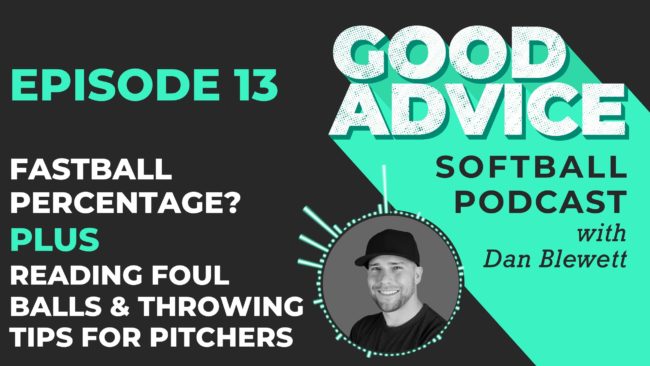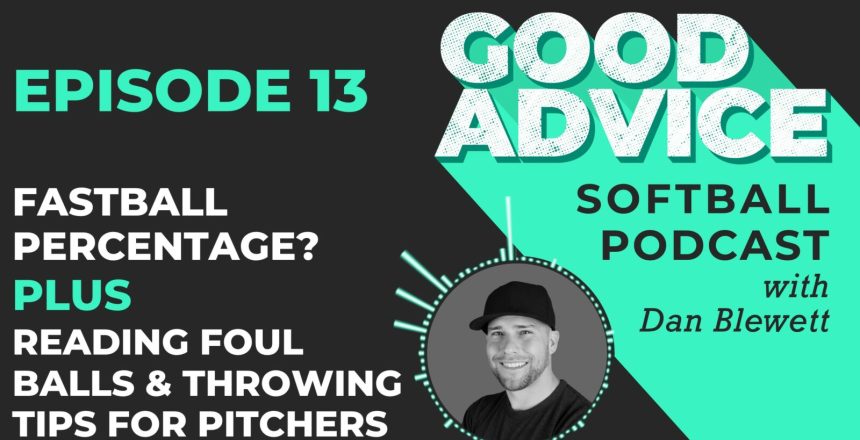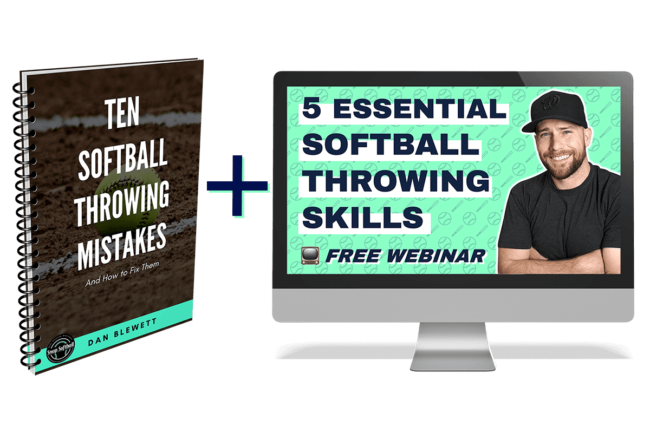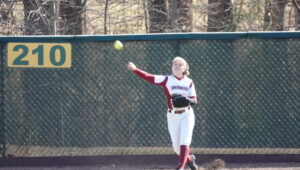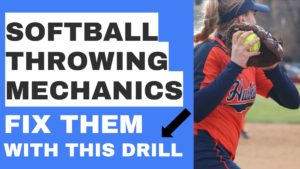*This article may contain product links which pay me a small commission if you make a purchase. Learn more.
What percentage of fastballs should softball pitchers throw? And, should they increase this percentage? Dan also talks about the windmill pitching motion blending with the throwing motion, and how pitchers can read foul balls.
To submit a question for the Good Questions Q&A segment, make a voice recording and email it to Dan at hello@danblewett.com. Want to support the show? Enroll in one of Coach Dan’s online throwing courses or his mental skills course. Use code GOODADVICE to save 20% on any course, just for being a listener. Sign up for Dan’s Email list and get his free throwing eBook, and follow up with him on the interwebs: YouTube Channel | Twitter | Snapsoftball.com
Podcast: Play in new window | Download
Subscribe: Apple Podcasts | Spotify
Transcript: EP13 – Throwing a Higher Fastball Percentage; Pitching Motion Blending with Throwing; Reading Foul Balls
Hey, welcome back to the good advice softball podcast. I’m Dan Blewett on today’s episode, we’ve got three topics. Number one, I’m going to talk about pitching mechanics, blending with the throwing mechanics. So I made a video about this on YouTube, and I don’t know that it was properly interpreted. Maybe I just didn’t do as good a job explaining this one as I could have.
I probably need to use some examples. So I’m going to try to explain it thoroughly over the magical airways. Um, so we’ll see how this goes. Uh, second one, number two. We’re going to talk about throwing fastballs and soft wall. This is something that I’m a little bit of an outsider too, but I want to talk through the rationale of isle, why softball should be throwing more fastballs than they are.
And lastly, we’ll talk about reading foul balls. So I’ve done some videos about pitching strategy recently that are in the queue. They’ll be on my YouTube channel soon. And I want to chat a little bit about that as well today. So number one, let’s talk about the pitching motion, blending with your overhand throwing motion.
So, number one, there’s a very real phenomenon. So I’ve seen it many, many times throughout my years, working with softball players, I did two clinics. Uh, this past month saw, you know, of the three or four pitches on each team. I’d say. But I think two girls from each team had this blend in their throwing motion and what it looks like, what looks like is this, the arm back swing tends to just be really high.
And it tends to jut up to the sky really, really fast. So when you’re a position player, whether it’s catcher in a field or outfielder, There’s no real good reason for your arm to shoot up into the sky. And there’s no good reason for your arm to stay, check out straight. Like your arm goes over your head when you’re doing your windmill motion.
Uh there’s no, again, there’s no like real good reason for your body to do that. And when you’re a visiting player, obviously, if you’re a windmill pitcher, Then your arm is going to be doing that motion over and over and over when you practice. So it stands to reason that this would just start to blend in with your overhand throwing motion, right?
Like the way your arm action is when you pitch is very different than the way you overhand throw in softball. So. I worked with a girl. And this is what I explained to my YouTube video that we worked together for man a really long time between I think, sixth grade. And, uh, when I sold the Academy, I think she was 16 or 17.
So pretty long time. And like clockwork every year we’d come back and her throwing mechanics would have been more look more like her pitching motion than our throwing motion, where she just starts to. Really elongate her arm gets this really long back swing with her elbow, very straight and reaching to the sky.
And the main problem that’s caused is that the upper arm. So this is your bicep, essentially your upper arms should be. Flat like parallel with your shoulder line or slightly below your shoulder line when your stride foot hits. So when you feel the ground ball or you catch a fly ball and you start your throw and you stride, when that stride foot comes down, which would be your left foot for a righty, your shoulders should be level.
With the ground essentially, or slightly uphill and your upper arm again, this is like where your bicep is. That would be in line with those. Yeah. Shoulders never above it. Sometimes a little bit below it. A little bit below it’s. Okay. Any amount above your shorter line is bad. So it’s bad because your shoulder pinches, and that’s just fancy terms for your, basically the shoulder muscles or the, the, the, the shoulder muscle starts to hit the bone of your shoulder girdle as it tries to raise overhead.
So if you want to do this while you’re sitting there driving your car, if you just lift your arm straight up to the side, like you’re making a snow angel while you’re standing, you’ll feel that your shore starts to pinch and starts to get tight. And it really can’t go that much higher. That’s the impinging, like your shoulder muscles are hitting the bone and it’s not going to let it go that much farther.
So this is what happens when you start to raise your hand or your arm overhead too much in your throwing motion. Obviously when you’re doing the, the windmill style pitching, the arm is going way above your head and then slinging back and slingshotting through to release the pitch. So. You know, again, this back swing of the way, your honor arm goes above your head, and there’s not really like a shoulder pinch component to it, which is a major component in the overhand throw.
That’s where they just start to have a disconnect. So the windmill motion is very much up and down and around with a long arm. And the overhand throwing motion is hands separate down elbow and shoulder blades, pinch back, and then the body rotates and the arm is bent at around nine degrees or less. So they’re very different.
Uh, they’re very different throwing emotions and they don’t really have the same sort of movement pattern to them. So again, the, the window motion is back up and around and the throwing motion is shoulder blades pinched behind the body. And then the core rotates. So, this is not a problem that every pitcher has.
So that’s number one. So if your daughter’s a pitcher, she might not have this issue, but a lot of players do and in varying degrees. So it just depends on the player. It depends on how stable they’re throwing mechanics are. Depends on how good their throwing mechanics are. Um, and just, I guess, depends on.
How they grew up and how they were taught early. And then just again, like how plastic their mechanics are, some players are more plastic than others where they’re just like constantly changing other players. Like they throw the same way when they were 10 as they do when they’re 17. So it just depends.
So this is something to look out for. I’m not sure. I explained the may, this just, wasn’t one of my best videos on YouTube. Um, and I probably needed. To, to show some examples where, um, and I do have some, so I’ll probably do that maybe in a follow up down the road, but at some to look out for. So if your daughter is a pitcher, Get some slow motion video of her from the side and watch her, her back swing of her throwing arm and see if you can see the influence of her pitching motion.
See if you see it kind of a long game, they get really long, have this big arm circle and see if it raises above her shoulder line. I bet you that in, you know, if, if 10 people here listening to this, I bet three or four of your daughters will. Show signs that their windmill motion has sort of blended in with your throwing away.
Okay.
All right. Second on the docket today, let’s talk about throwing fastballs. So. I was puttering around YouTube a little bit, and I found a channel called fast pitch power. So shout outs of fast pitch power. And, uh, I watched literally one, exactly one video. I watched the one that interested me, which was. A guy talking about how many pitches a player should throw.
And I liked his opinion on it. And I also liked that he briefly mentioned that he thinks softball players should be throwing more fastballs that they, than they do. And he actually referenced baseball. He said, look in baseball. These guys throw 60 to 70% fastballs yet in softball. We’re nowhere close to that.
He said, and I don’t understand why he said it’s not that easy to hit a straight pitch. And we should be relying on this strong, fast pitch, uh, as one of our repertoire. So I was doing some, uh, some foul ball stuff and some stance and some take stuff. So for my YouTube channel, I did a video on reading foul balls.
I did another one on reading, um, hitters takes. So in doing that, I found myself talking about. All those things being predicated off of swinging off the fast ball. So if you’re a pitcher that throws fast balls, that’s your fastest pitch. Right? And so then when you throw a hitter, your fastest pitch, they’re going to have to see how their bat speed matches up.
Like do, can they catch up to that? Right. And so if you’re not often throwing fastballs, you’re not often getting this Intel as to whether a girl can catch up with your fastball. So say you’re a pitcher and you throw 60 miles per hour, which is hard obviously for, um, high school or below. If you throw a 60, there’s a lot of girls who you’ll just throw that ball by them.
Right. But you really won’t know that until you throw your fast ball and see how they swing. But if you’re a pitcher who’s throwing 30% fastballs or 40% fastballs and you’re throwing lots and lots of off-speed stuff. You’re not really getting to get this sort of like set point where you can say, okay, relative to my fastball, this girl’s bat speed is X it’s this fast, or it’s this slow, she can catch up or she can’t or whatever.
And then from that we know, okay. Off speed pitches have to beat their off-speed compared to what they’re also be compared to your face fastball. So if you’re always throwing up speed junk, and you don’t really throw your fastball, it’s not really, off-speed really relative to anything else. You’re really just throwing a lot of slow pitches.
So if you threw all drop balls, for example, It’s not an off speed pitch. It’s just the speed. Right? And obviously that’s an extreme example. No one does that, but if you’re throwing such a high percentage that most of your pitches are off speed, then off-speed is your speed and fast ball is essentially speed to that.
So, When the fastball ratio gets below 50%, which it sounds like it is. And that there’s really not a high prevalence of throwing fastballs in softball, which I also don’t understand because it’s still around ball. It’s still around bat and it’s easily your locate, your straight stuff, like your fast ball over anything else.
Right. So, I don’t really understand historically where that’s come from. I’ve had this conversation with a couple, a former division, one players that I know, and they’re like, yeah, they don’t really throw that money fast balls, but it’s not like female athletes are just like going to destroy these. Are they, I mean, is the fastball really that easy to hit?
I don’t think it is, especially, you know, 60 miles per hour from such a short distance. They’re still reaction time. You locate it. Well, I mean, you don’t just automatically hit a dinger on an outside third fastball just cause it’s straight. But the big thing here is having that set point relative to the off-speed stuff.
So say you’re throwing fastballs down the middle and the first pitch of the bat and a girl swings and she fouls it off and she’s way behind it. So she’s a writing. She fouls it off down the first baseline. She’s really late that tells you that her bat speed is slow. Based on your fast ball. So now you can bring the fast ball farther inside, farther in towards her, and she’s going to have an even tougher time of getting around it.
Now you’ve also found another good, valid reason to throw a second fast ball that a bat. And then this is what baseball guys do so well. We throw our fastball often and that gives us a basis for saying, okay, I just threw my 92 mile per hour fastball down the middle. And this guy. It was way, it just got blown past him.
So this guy can’t catch up to 92 down the middle. Therefore, if I throw a 92 on the inside corner of the plate where he, he essentially has to get his barrel out, even faster. Then he’s going to have even less of a chance to catch up to my fastball. So then you do that. You go inside and he’s even later.
So now you’re like, okay, I can beat this guy on fastballs. Probably I can go up. I can go inside again. Or if he starts to try to cheat and catch up, now I can bounce a curve ball, or I can throw a change up and he’s going to be just. Done right. But when you’re never throwing enough, fast balls, you’re not getting that Intel about bat speed.
You don’t really know because if you throw a first pitch drop ball, you haven’t learned anything about their bat speed because everyone can catch up to an off speed pitch. Right. And when you throw a first pitch change up or a screw ball or whatever, You’re not learning anything about their bat speed because everyone can catch up again to an off speed pitch.
So to have this Intel, to get a set point and get an idea of what a hitter’s bat speed looks like, you have to throw the hard stuff, and it’s not to say you have to suddenly throw it all the time, but you have to throw it in off, especially early in the counts to get an idea of where hitter’s bat speed is.
And then you start to manufacture the bat after that. So. If you go down down the middle of the first pitch and they put a decent swing on it, maybe they just put it in place it’s over. Or so you go out or half and they fouled off just foul where it was an outside location and they fouled off fouled and they’re like, okay, that’s probably on it.
For the most part, maybe they fell on straight back and you’re like, okay, definitely right on it. Right. So throwing fastballs gives you an idea of what hitters can do, and it’s still just not that he’s a barrel, the ball up, and most girls don’t have that much pop anyway. Like how many girls are taking you deep in 13, you softball, where you have to really actually be afraid of them swinging the bat and making contact, not really that money.
Right? So. Obviously I’m an outsider to softball. And, um, I think if anything is some fresh eyes helps that because a lot of people need to ask question, not just do things the same old way they’ve always been done. Um, but at the same time, there’s a lot of lessons from baseball that softball players can learn from.
And vice versa. There’s a lot of things going on in the software world that maybe baseball can learn from. But I think the main thing here is that if you’re going to get some of this Intel and I encourage you to check out my upcoming YouTube videos in the next couple of weeks about reading foul balls, about reading hitters, stances, and about reading, how hitters take pitches.
Cause that’s important too. Those concepts kind of break down. All you’re throwing is junk because you don’t really get a good set of where their bat speed is and what they can do naturally is hitters.
Okay. So let’s in this last segment here, let’s go into. Reading foul balls. So I am going to have to go back to throwing fastballs here. So everything I’m going to assume right now is you’re throwing a fast ball, a heater, something hard right down the middle. So if you throw and we’re going to for this, for all intents, as per the intents and purposes here, everything is going to be assumed essentially down the middle.
And the reason it’s good to throw the ball down the middle on first pitches, not all the time, but some of the time is that it’s. If you execute right down, the middle hitters are going to show you exactly how good their bat speed is. Because if you throw a pitch down the middle and a hitter, can’t catch up to it.
It tells you right then they’re definitively that their bat speed is slow relative to your fast ball speed. If you throw on the outside corner, however, for the first pitch and they swing late or they foul it off to the opposite field, it doesn’t tell you as much about the sheer velocity of the pitch relative to their bat speed, because the location also plays a role.
And now you have two factors to consider, and it’s not clear, which of them is the predominant factor. So throwing the pitch down the middle of the plate early, Gives you again, two things. Number one more margin for error for throwing a called strike and getting ahead, which is critical. And number two, it’s going to give you more relevant Intel about how fast their bat speed is because you’re giving them your fastest pitch.
So if they can’t catch up to your fastest pitch right down the middle, they’re definitely not able to catch up to the facet that same fastest pitch, that fast ball on the inside bar of the plate. And it’s going to give you ideas of what you should and should not do. So if you throw a pitch, so let’s, let’s talk for foul ball, number one, foul balls, the opposite way.
So if you’re writing, it means spraying them over the first base. First base side, if you’re left to the third base side, if you throw a fast one on the middle and a hitter swings late and they foul it to the opposite field, that’s telling you that they don’t have enough bat speed. To catch up to your fastball.
Now they could be like indecisive. So there’s always context, right? You have to read it. They could be, maybe they’re looking, sitting on a drop ball and they got a fastball. So that’s not really going to tell you if it was their bat speed or if it was just fact that they were looking for the wrong pitch or maybe they’re just indecisive and they just, you know, we’re kind of like Spacey and just decide to swing late.
But a lot of times when you feel like you’re watching and you say, okay, they took a pretty normal swing. It seemed like they were on it. Like they were ready. Like there was something floating around their brains too much. That that was a pretty good indicator of them taking a hack at me. Then you have a good idea of where their bat speed is.
So if they swing at that first pitch and they out off late, it tells you a good amount about what you should do the rest of the bat, which is probably bring the ball into them. With your fast ball, stay hard or go up with your rise ball against staying with your fastest pitches. Because if they can’t get around on a pitch down the middle, they definitely can’t get around on pitch inside and they definitely can’t get can’t get around up.
So if you throw it in the middle of your fast ball and they fell it off late, and then you throw them a change up, you just help them. You just gave them extra your bat speed to catch up to you through them. A slower pitch when their bat matches a slower pitches speed. That’s a really critical point to understand this happens.
All the time in baseball, because we do throw a lot of fast balls and you’ll see fat pitcher go, boom, fastball by you. Boom. Another fastball by you. Then there’s a new curve ball and the guy smokes into the gap and you’re like, What what happened? Well, you just gave him an easier, slower pitch to hit when he proves doesn’t have any bat speed.
So again, this is another reason that fastballs should be part of your repertoire. That that’s an important thing to be doing. Uh, the second type of firewall, let’s talk about pitches, fouled straight back. So when a foul ball is fouled straight back, it typically means what we think it means, which is essentially that they’re on it.
But obviously, you know, if, if hitters were perfectly accurate with their barrels all the time, Then they wouldn’t be miss hitting stuff. Right. Everything they’d swing. That would be a line drive. They’d just destroy the ball all the time. But we know that pitch, that hitters get the ball right down the middle and they pop it up.
They get pitches right in their wheelhouse and they hit a routine ground ball to short. So those are like barrel inaccuracy problems. They’re just not getting the barrel to the ball. As well as they hope they would. And that happens on foul ball straight back as well. So when you see a hit or foul ball straight back, it means you just kinda got lucky a little bit and natives tend to miss just beneath it.
And they might not miss the next time. So it’s probably time to switch pitches, whether it’s switching locations or switching pitch velocities altogether. Yeah. The next type is the looping opposite field pop up. That goes foul. So this one, it’s kind of like, if you’re righty, you’ll pop it up and it’ll kind of meander over your dugout or you’ll hit it, you know, over the, on deck circle.
So slightly to the opposite field side and up. This one is typically saying that the hitter got overpowered a little bit and their barrel dipped beneath the ball. And they’re also slightly late. Those factors combined. And it just kinda depends on the hitter’s swing and all that. But typically if they’re falling it off that way and high under the sky or high end of the sky, it means they got underneath it, obviously.
And their barrel was just kind of dragging through the zone. So maybe they were, you know, just like a little bit overpowered and couldn’t get their barrel to the top of the ball. And that’s why they pop it foul. Lastly, the last type is pulling it, pulling it foul. So if they pull the ball foul, obviously this means that they’re ahead of it.
That they’re on time with it, whatever, but there’s still red herrings here as well. So if you pull a ball foul with authority, A, you could just have great bat speed and great hands and you have better bat speed in the pitcher does velocity, or you could be ambushing the pitcher and you’re just like, Hey, it’s two and Oh, I know a fastball’s coming.
So I’m going to just like take a huge leg kick and I’m gonna be ready and I’m gonna go whammo. That happens as well. And on first pitches, a lot of times girls will ambush where they’ll gear up and they’ll start their swing early. Because they have a good idea of pitches coming to the center part of the zone.
So sometimes when to hit her, pulls the ball foul, it’s not because she’s got great bat speed. It’s because she’s ambushing you. And she’s trying to get her bat start early to try to like drive the ball and kind of cheat her way out of the bat in the first pitch. So you have to read into it and watch the hitters and look for context and try to figure out which of those things it actually is.
Because if you just look at the foul ball and say, Oh man, this girl’s got crazy fast bat. Well, let’s wait a minute. Does she actually, or did she just kind of like cheat her face off and just was ready for it? So it’s hard to know. A lot of times the, the spot in the batting order will give you some clues.
What they’ve done early in the, earlier in the game. If there’s previous a bath, we’ll give you clues. Also your own velocity will give you clues. So if you throw really hard and you see a girl smokes, a ball, foul pulls a foul off you, and she’s like the eight hole hitter. Chances are the eight hole hitter.
Doesn’t have enough velocity to get around on you if you’re actually a hard thrower for your level. So in that situation, this is happened to me plenty of times in my career, if an eight hole hitter like yanks me found the first pitch, I’m like, Screw you bro. Like you just took a free hack cause you’re just trying to catch.
Cause you know, you don’t have any bat speed and that’s often the case. Whereas, you know, the usual suspects, actually the ones who are going to be at a pull, you foul, which are like two hitter, three hitter, four hitter, maybe five hitter, right? The people with the bigger bats, the bigger bodies. So if it’s not a two, three, four, five hitter, you know, we’ll include the one hole hitter in that as well, usually too.
So it’s not like the one through four, one through five, whatever the best four or five hitters on the team. Then you should probably like raise an eyebrow with them and say, how did you get around on me? If you’re a hard thrower, if you’re not a hard thrower, then you know, more people are going to get around on you and you have to kind of figure that out on your own.
But again, well, foul can often mean that they’ve got great bat speed hands, and you just started using start changing speeds and mixing it up location wise as well. Uh, or again, it could be that kind of red herring where they’re ambushing you they’re just like geared up, they’re guessing fast ball. And they’re just trying to get the bat start early sometimes because you’re a hard throw and they know it.
There’s going to be like, I got to start early and that’s normal. Right. Because they don’t want to just like not cheat and go down, swinging know they’re going to get with, with, with so. Those are all important factors to figure out and make sure if you’re reading foul balls, like a, you know, you have someone else so that your catcher to bounce ideas off you like, Hey, why do you think she swung?
Like that was she actually laid on that pitch? You know, this is where having a good battery, the pitcher and catcher. Is important. And you’re always going to be able to bounce ideas off each other. Sometimes as a pitcher, it’s harder to tell where a pitch was. Um, because your eyes we’ll leave. We’ll leave the middle a little bit.
Right. As you release stuff like that. So having a catcher to say, Hey, you know, Hey catcher, um, you know, where was that pitch? Was it as far in, as I thought it was? Or how did she get around on that? Or why do you think she wrote that ball foul? You know, those conversations are important. So the mind game in pitching is, is always important and players should be as, uh, as observant as possible using stuff like reading, foul ball, their advantage.
That’s all the good advice I’ve got for today. If you enjoy the show and would like to support me while also helping yourself. Enroll today in one of my online softball courses, my she’s got a cannon throwing courses, come with pricing plans for any budget. And my resolute athlete, mental skills course will help your daughter or team go the mindset of a champion enroll in any of my courses through the links in the show notes and save 20% code good advice just for being a listener.
Be sure to subscribe to my weekly email list where you’ll get updates on all my new videos and episodes, nearly 4,000 people get my emails and you should to sign up to the link in the show notes. Lastly, who do you know, who can use some good advice? Please share this podcast with a friend, subscribe on iTunes, Spotify, or wherever you listen to podcasts.
And subscribe to my snap, softball, YouTube channel, where you’ll find this podcast and hundreds of softball, instructional videos. Back when I was a player, I was always thankful for good coaches and good advice. I’m Dan Blewett and I’ll see you next time. .

